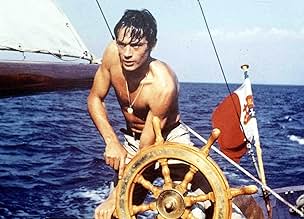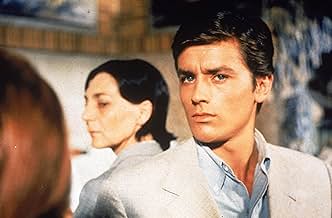VALUTAZIONE IMDb
7,7/10
22.804
LA TUA VALUTAZIONE
Tom Ripley è un imitatore, un falsario e un criminale di talento. Ma è più di tutto questo, anche se non lo sa.Tom Ripley è un imitatore, un falsario e un criminale di talento. Ma è più di tutto questo, anche se non lo sa.Tom Ripley è un imitatore, un falsario e un criminale di talento. Ma è più di tutto questo, anche se non lo sa.
- Regia
- Sceneggiatura
- Star
- Premi
- 1 vittoria in totale
Marie Laforêt
- Marge Duval
- (as Marie Laforet)
Billy Kearns
- Freddy Miles
- (as Bill Kearns)
René Clément
- Le serveur maladroit
- (non citato nei titoli originali)
Walter Grant
- Bit
- (non citato nei titoli originali)
Paul Muller
- Blind Man
- (non citato nei titoli originali)
Jacqueline Parey
- Ingrid
- (non citato nei titoli originali)
Romy Schneider
- Freddy's companion
- (non citato nei titoli originali)
Recensioni in evidenza
I found this film more interesting than the recent Minghella opus because the people were more disturbing.
Alain Delon is too good-looking to be dismissed as the geeky wannabee Matt Damon plays. His insanity in a pretty package is as unsettling as Gene Tierney's in "Leave Her to Heaven." Delon looks like Maurice Ronet's brother, and you can see him wonder why if he's just as handsome as the other guy, why doesn't he have as much money? Ronet is more unpredictable than Jude Law as the whimsical rich boy and his death is every bit as shocking.
I can't imagine that Anthony Minghella hadn't seen this version before making his own. He probably regrets Scorsese's reconstruction of Rene Clement's film so we can all make the comparison. Some scenes play like a shot-for-shot remake. Billy Kearns's brutal Freddy Miles is an obvious template for Philip Seymour Hoffman's more calculated and less powerful performance, and Gwyneth Paltrow's final breakdown is VERY close to that of Marie Laforet's.
All through the 1999 film, I kept wondering why everybody couldn't see what was wrong with the toad-like Damon. In this one, Delon's plausible, even glamorous exterior made the success of his deceptions more understandable, and more frightening.
Alain Delon is too good-looking to be dismissed as the geeky wannabee Matt Damon plays. His insanity in a pretty package is as unsettling as Gene Tierney's in "Leave Her to Heaven." Delon looks like Maurice Ronet's brother, and you can see him wonder why if he's just as handsome as the other guy, why doesn't he have as much money? Ronet is more unpredictable than Jude Law as the whimsical rich boy and his death is every bit as shocking.
I can't imagine that Anthony Minghella hadn't seen this version before making his own. He probably regrets Scorsese's reconstruction of Rene Clement's film so we can all make the comparison. Some scenes play like a shot-for-shot remake. Billy Kearns's brutal Freddy Miles is an obvious template for Philip Seymour Hoffman's more calculated and less powerful performance, and Gwyneth Paltrow's final breakdown is VERY close to that of Marie Laforet's.
All through the 1999 film, I kept wondering why everybody couldn't see what was wrong with the toad-like Damon. In this one, Delon's plausible, even glamorous exterior made the success of his deceptions more understandable, and more frightening.
Rene Clement's "Plein soleil" offers a young Alain Delon as Tom Ripley, a character known to more recent audiences as the hero of the Anthony Mingella 1999 "The Talented Mr. Ripley." It is nice to note that both films hold their own well, with the Mingella providing more character and background information than the Clement version.
Delon, who was to become a favorite actor of Visconti and other fine French and Italian directors, renders a skillful performance, along with Maurice Ronet as Phillipe Greenleaf (known as "Dickie" in the later Mingella opus).
Clement keeps the camera focused on the handsome M. Delon (as did Visconti) with stark closeups to show detailed emotional reactions. Delon manages to rise to the challenge in subtle ways, and to project a fully realized character. While Clement fails to provide much background as to why this character acts the way he does, Delon's photogenic countenance somewhat overcomes this void by masking it with personality and charm.
We can be thankful to Martin Scorcese for the fine reprint of this memorable French thriller, known in the UK and USA as "Purple Noon."
Delon, who was to become a favorite actor of Visconti and other fine French and Italian directors, renders a skillful performance, along with Maurice Ronet as Phillipe Greenleaf (known as "Dickie" in the later Mingella opus).
Clement keeps the camera focused on the handsome M. Delon (as did Visconti) with stark closeups to show detailed emotional reactions. Delon manages to rise to the challenge in subtle ways, and to project a fully realized character. While Clement fails to provide much background as to why this character acts the way he does, Delon's photogenic countenance somewhat overcomes this void by masking it with personality and charm.
We can be thankful to Martin Scorcese for the fine reprint of this memorable French thriller, known in the UK and USA as "Purple Noon."
Purple Noon with Alain Delon, Maurice Ronet,and Marie Laforêt, is the chilling original to The Talented Mister Ripley. The blindingly beautiful Mediterranean background serves as a stark contrast to the lives of three spoiled and amoral characters on holiday in Italy. This original of The Talented Mr. Ripley is far different from the more recent movie, with Delon being more believable as Tom Ripley, his unbelievably handsome face hiding an evil mind, willing to do whatever it takes to trade places with Philippe Greenleaf.
There are some gratuitous shots here for 1960, and I wasn't real impressed with Maurice Ronet,who seemed too old for the part of Philippe, but on the whole, an enjoyable experience with great plot development and cinematography. The movie pulled you in like a day in the Riviera.
There are some gratuitous shots here for 1960, and I wasn't real impressed with Maurice Ronet,who seemed too old for the part of Philippe, but on the whole, an enjoyable experience with great plot development and cinematography. The movie pulled you in like a day in the Riviera.
Visually, this film could serve as a cinematic poster for a Mediterranean cruise. Cinematographer Henri Decae draws us into the film with its alluring Italian locales and gorgeous panoramic vistas. Bright, complementary hues and high color contrast translate into eye-popping reds and yellows. And, of course, there's the deep blue color of the sea, and a brilliant sunlit sky. Such is the setting for a story wherein three attractive, young adults (Tom, Philippe, and Marge) test a 3-way relationship that is far more complex than it first appears.
Indeed, trouble lurks beneath the surface (so to speak), in this "Italiano paradiso" thriller. In the first forty minutes, the psychological motivations of our three beautiful people are unclear and subject to change. It's hard to tell who is doing what to whom. Subsequent to this narrative setup, we see exactly where the story is headed. Because "Plein Soleil" is a psychodrama, casting is important. The three leads (Alain Delon, Maurice Ronet, and Marie Laforet) are all convincing in their roles.
I have not read the Highsmith novel on which the screenplay was based. So I cannot make an intertextual analysis. I do think this 1960 film is superior, for various reasons, to the more recent remake.
Adroitly directed by Rene Clement, with a buoyant musical score by Nino Rota, "Plein Soleil" is a character study of an amoral pleasure seeker whose charming personality masks the evil within. The juxtaposition of inwardly criminal intent with outwardly idyllic scenes of Italy and the Mediterranean results is an art house film that is both picturesque and suspenseful. It's a film that appeals both to our eyes and to our brains.
Indeed, trouble lurks beneath the surface (so to speak), in this "Italiano paradiso" thriller. In the first forty minutes, the psychological motivations of our three beautiful people are unclear and subject to change. It's hard to tell who is doing what to whom. Subsequent to this narrative setup, we see exactly where the story is headed. Because "Plein Soleil" is a psychodrama, casting is important. The three leads (Alain Delon, Maurice Ronet, and Marie Laforet) are all convincing in their roles.
I have not read the Highsmith novel on which the screenplay was based. So I cannot make an intertextual analysis. I do think this 1960 film is superior, for various reasons, to the more recent remake.
Adroitly directed by Rene Clement, with a buoyant musical score by Nino Rota, "Plein Soleil" is a character study of an amoral pleasure seeker whose charming personality masks the evil within. The juxtaposition of inwardly criminal intent with outwardly idyllic scenes of Italy and the Mediterranean results is an art house film that is both picturesque and suspenseful. It's a film that appeals both to our eyes and to our brains.
Extremely well done, tightly edited, well acted (by everyone, including the small roles, especially the actor who has to appear dead with long camera shots in a tense scene in the hotel). Delon is perfectly cast, with his calculating cool.
The cinematography is gorgeous, especially the scenes on the yacht---nothing gimmicky, but shot with an expertise that gives true drama to the action. You can feel the waves, the wind, and the sun. The colors are vibrant on the DVD. Though a scene like this in a typical movie today would include a heavy ominous score, the director simply lets the sound of the wind create the tension. The score (by Nina Rota), in fact, is understated, unlike anything today. Even the opening credits have style.
The cinematography is gorgeous, especially the scenes on the yacht---nothing gimmicky, but shot with an expertise that gives true drama to the action. You can feel the waves, the wind, and the sun. The colors are vibrant on the DVD. Though a scene like this in a typical movie today would include a heavy ominous score, the director simply lets the sound of the wind create the tension. The score (by Nina Rota), in fact, is understated, unlike anything today. Even the opening credits have style.
Alain Delon's Top 10 Films, Ranked
Alain Delon's Top 10 Films, Ranked
To celebrate the life and career of Alain Delon, the actor often credited with starring in some of the greatest European films of the 1960s and '70s, we rounded up his top 10 movies, ranked by IMDb fan ratings.
Lo sapevi?
- QuizAlain Delon's then girlfriend Romy Schneider appears in the very first scene as a friend of Freddie Miles.
- BlooperOnlookers are clearly visible in the background in the fish market scene.
- Citazioni
Philippe Greenleaf: That's why you took my bank statements?
Tom Ripley: Exactly.
Philippe Greenleaf: So you kill me and you're rich?
Tom Ripley: Don't miss a trick, do you?
Philippe Greenleaf: It seems awfully complicated. You'd be caught immediately.
Tom Ripley: No necessarily. I might not look it, but I've got lots of imagination.
- ConnessioniEdited into Spisok korabley (2008)
I più visti
Accedi per valutare e creare un elenco di titoli salvati per ottenere consigli personalizzati
- How long is Purple Noon?Powered by Alexa
Dettagli
- Data di uscita
- Paesi di origine
- Lingue
- Celebre anche come
- In pieno sole
- Luoghi delle riprese
- Ischia Ponte, Ischia Island, Napoli, Campania, Italia(as Mongibello)
- Aziende produttrici
- Vedi altri crediti dell’azienda su IMDbPro
Botteghino
- Lordo in tutto il mondo
- 108.821 USD
- Tempo di esecuzione1 ora 58 minuti
- Proporzioni
- 1.66 : 1
Contribuisci a questa pagina
Suggerisci una modifica o aggiungi i contenuti mancanti

![Guarda Trailer [English SUB]](https://m.media-amazon.com/images/M/MV5BYzkzMWVkMmEtM2I3Zi00MjE2LTkxZGYtZDYxMDFmMjBmMzM5XkEyXkFqcGdeQXRyYW5zY29kZS13b3JrZmxvdw@@._V1_QL75_UX500_CR0)































